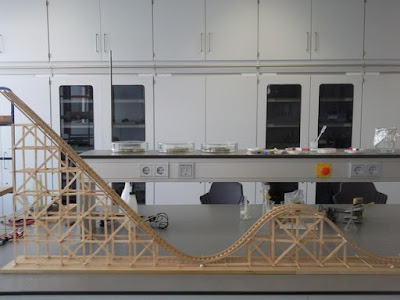2/11/15
Updated by Bill and Lilian
30/10/15 (Friday)
After receiving the completed
diagram from Angela we proceeded to prepare for the construction of the
roller coaster.
On Friday afternoon we purchased
the materials we required for the rollercoaster. These materials included:
• Skewers
• PVA Glue
• 500 Paddle pop sticks
• Poster card
• Cardboard
• A toy car
In total this costed around $20.
31/10/15 (Saturday)
Today we built the roller coaster
and completed it to an extent.
Process:
1 - Drill 0.3cm wide holes in
each end of each paddle pop stick.
3 - Created box structures that
would form the foundation of the roller coaster.
The project required 35 boxes in
total and thus this took us several hours. They were also frustrating and time consuming to make as they were unstable and had a tendency to tilt. Glue was later used as a counter measure.
4 - Positioning all the boxes in
the right places and taping them to the base cardboard.
5 - Cut out the tracks from the
poster card, each strip was about 4cm wide.
6 - Blue tacking each track to
the underlying structure
7 - One strip of track was bent
into a tear drop shape and used for the loop.
8 - Cut curves out of the poster
card for when the track needed to turn. )e.g. banked turn and end)
9 - Cut off any pretruding
skewers
10 - Add a clamp like mechanism
50cm from the end of the track to cause friction that would stop the car
(Note: We didn't have enough
poaster card to complete the track at the very end so the car
simply goes onto the cardboard
base. However, if does stop 50cm from the end of where the track was supposed
to end.)
This process took around 8 hours.
At the conclusion of the
roller coaster's construction, we realised we had made a few errors.
The energy acquired by the car at
the initial decent was not enough to propel it up the loop.
Additionally, the car kept on
derailing as their were no barriers.
These issues were later fixed on
Monday morning before exams.
2/11/15 (Monday)
As stated above there were
several issues with the completed model that were addressed today.
We spent 2 hours making
adjustments to the rollercoaster.
Firstly we increased the height
and steepness of the initial decent. We raised it from 30cm to 60cm
and the gradient was 2 instead of 1. This
addressed the issue of a lack of energy. Additionally, we also made the loop smaller, making it easier for the car to
scale.
In response to the constant derailing,
we added barriers at key points made out of duel paddlepop sticks. This was efficient as the car no
longer derailed.
The final product looked like this:
Next, we filmed our showcase video - However that will be covered by Angela in the next post.










